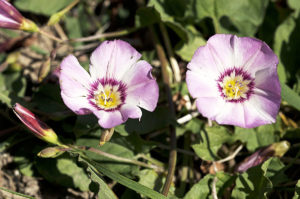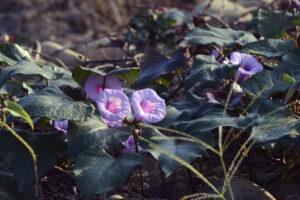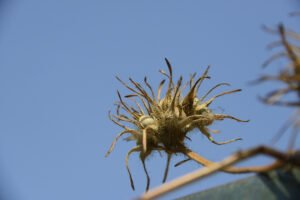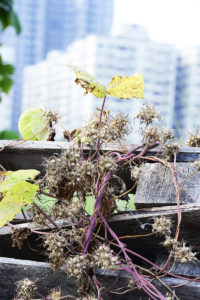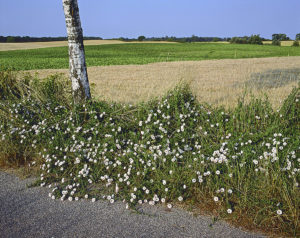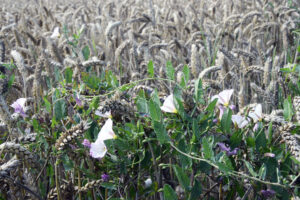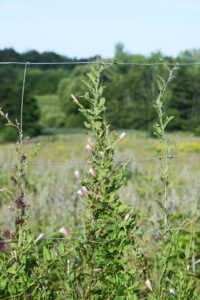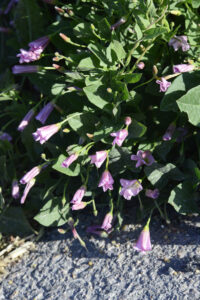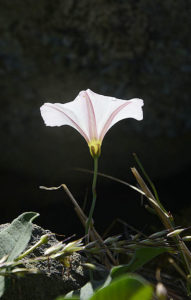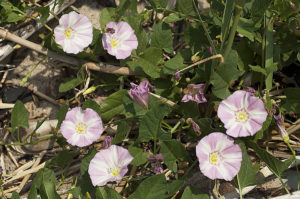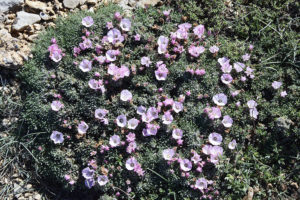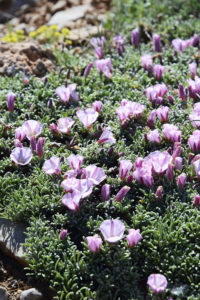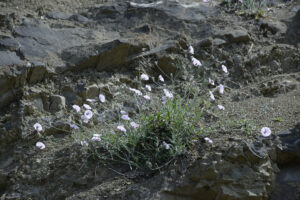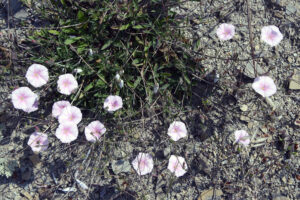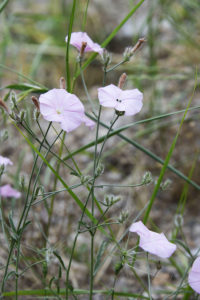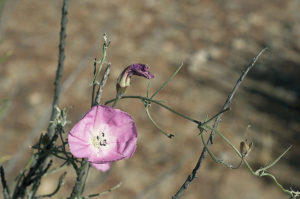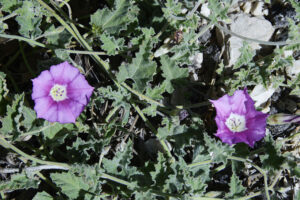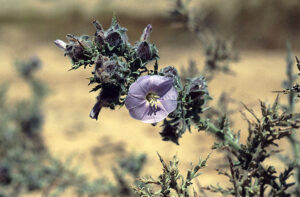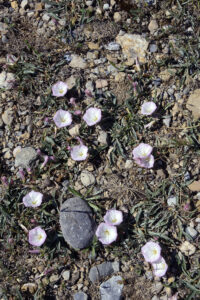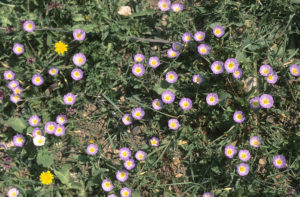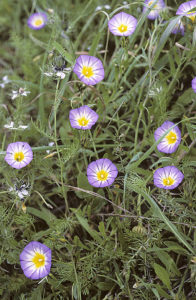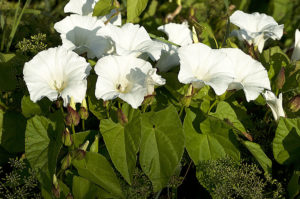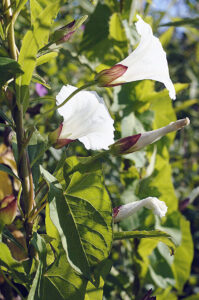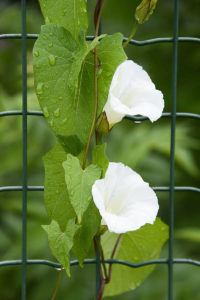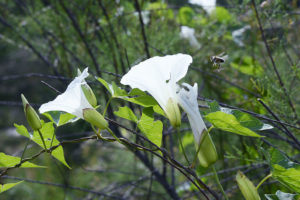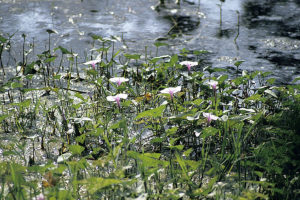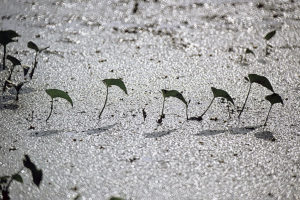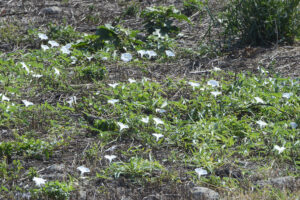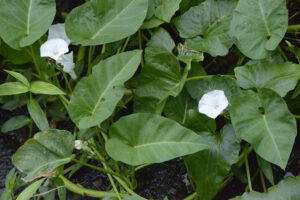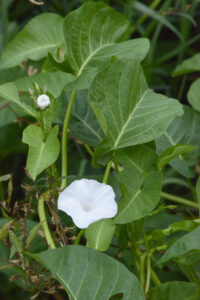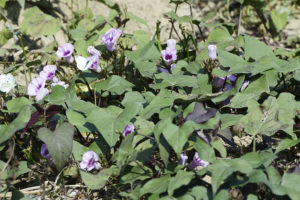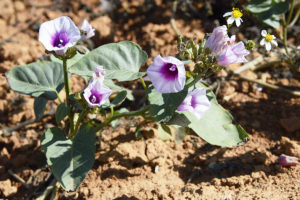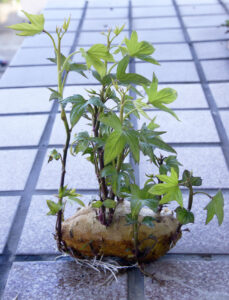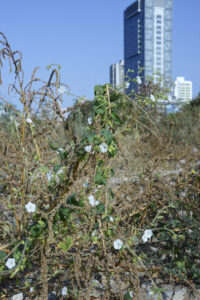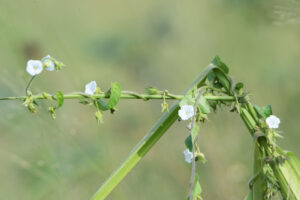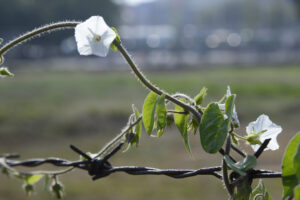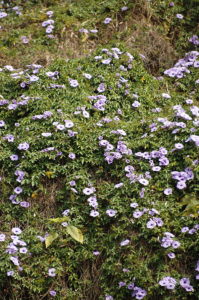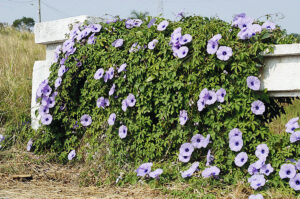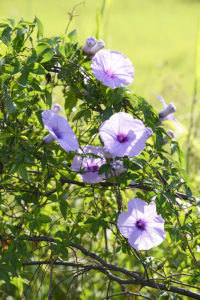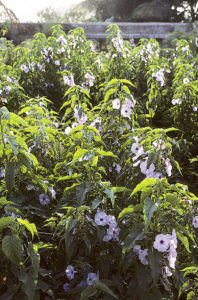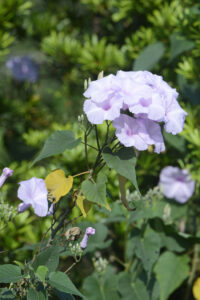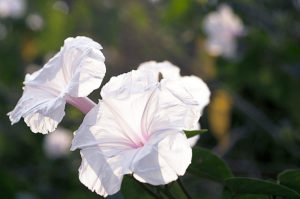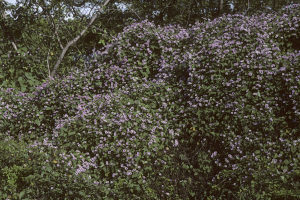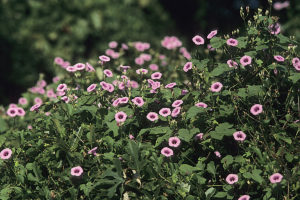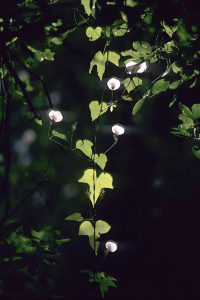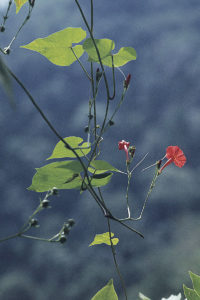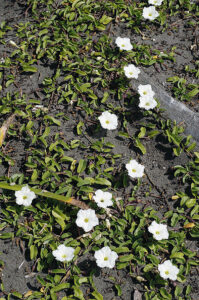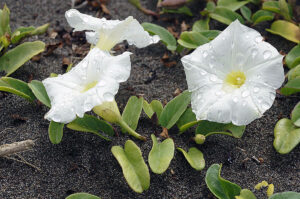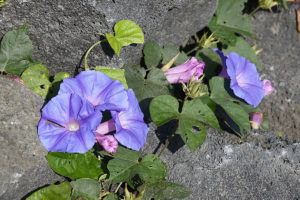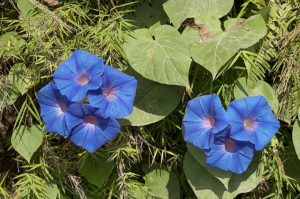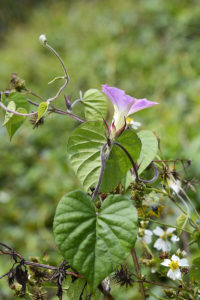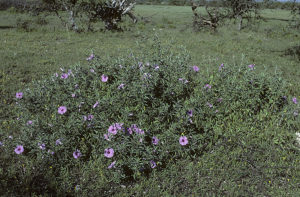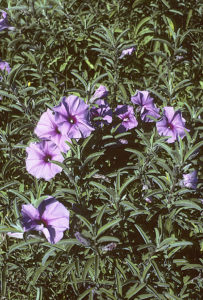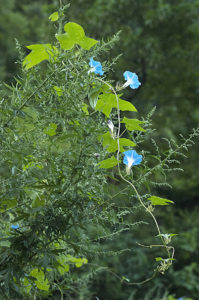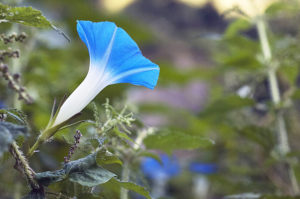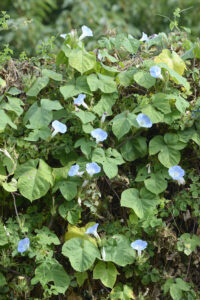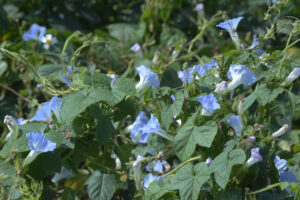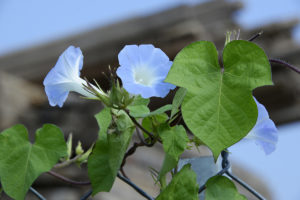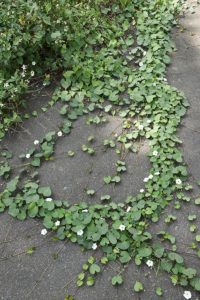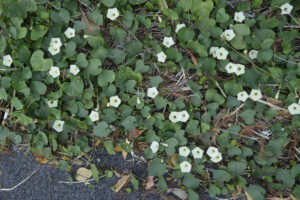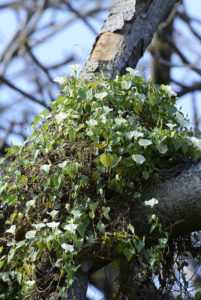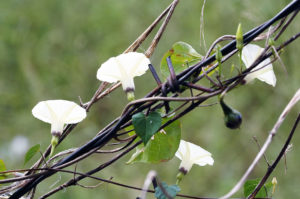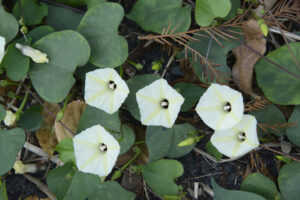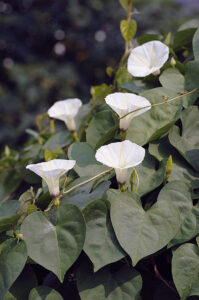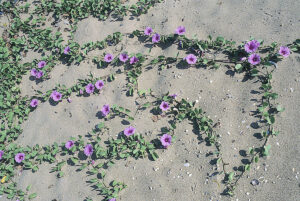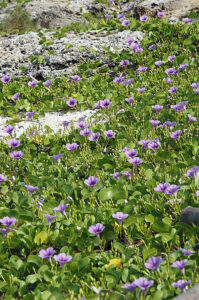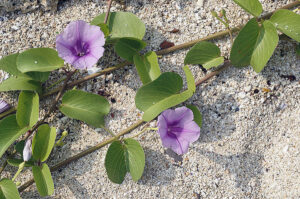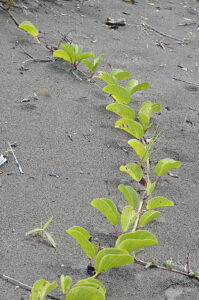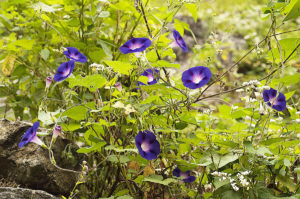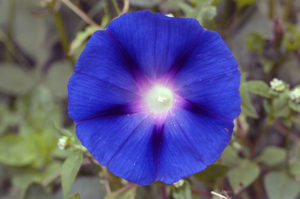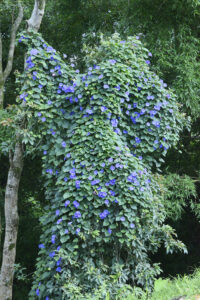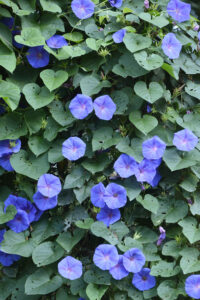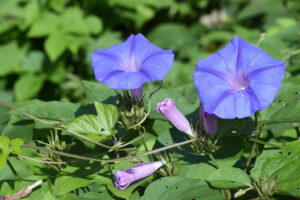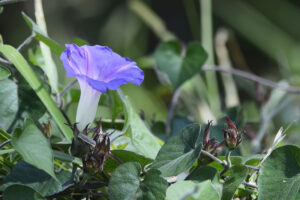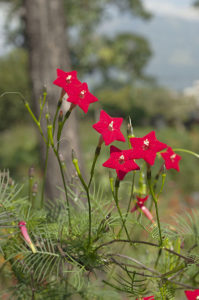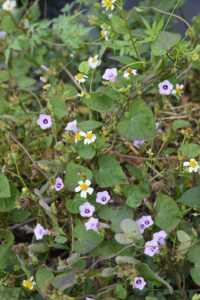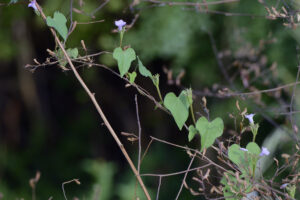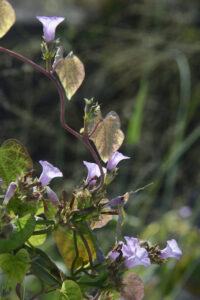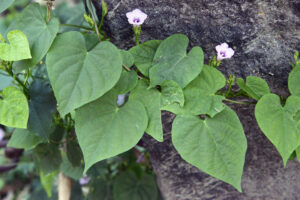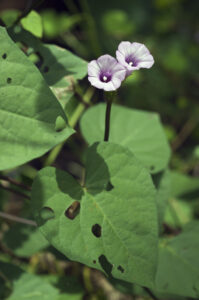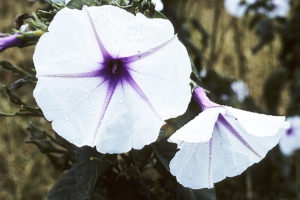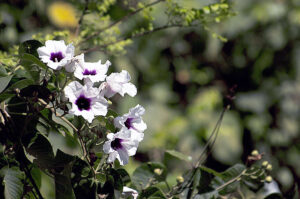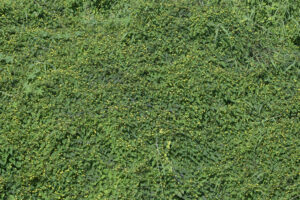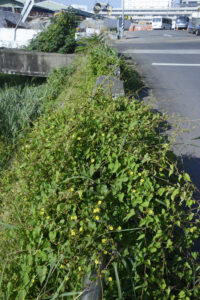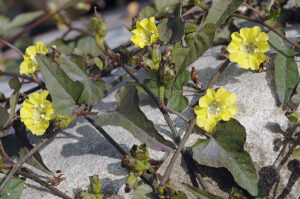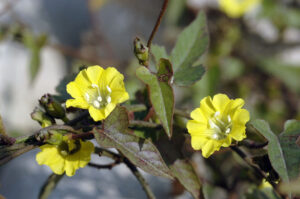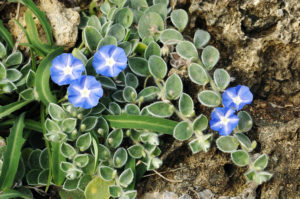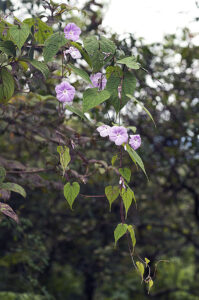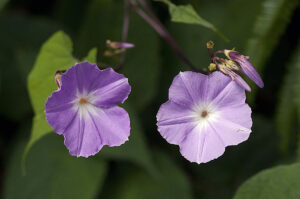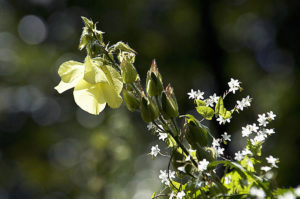Morning-glories and bindweeds
Glorious pink morning-glory (Ipomoea carnea) in morning light, Kerala, India. (Photo copyright © by Kaj Halberg)
Flowers of field bindweed (Convolvulus arvensis) are usually white, or white with pink markings, but a rose-coloured variety is not uncommon. This one was photographed on the island of Bornholm, Denmark. (Photo copyright © by Kaj Halberg)
Sweet potato (Ipomoea batatas) is a very important crop in many tropical and subtropical countries around the world. These plants were cultivated near Taichung, Taiwan. (Photo copyright © by Kaj Halberg)
Railroad creeper (Ipomoea cairica) is extremely common in Taiwan, where this picture was taken. (Photo copyright © by Kaj Halberg)
The morning-glory, or bindweed, family (Convolvulaceae) contains about 58 genera with close to 2,000 species, most of which are herbaceous vines, but also some erect herbs, shrubs, and trees. The flowers of almost all species are funnel-shaped with five fused petals, and many are quite showy. The leaves are simple and alternate, often heart-shaped, and without stipules (small leaf-like bracts at the base of the leaf-stalk).
The stems of the major part of these plants are winding or twining around other plants, or anything upright, hence the family name, derived from the Latin convolvere (‘to wind’ or ‘to wrap’ (around)), ultimately from con (‘with’) and volvo (‘to roll’).
In his delightful book All about Weeds, American botanist Edwin Spencer (1881-1964) writes: “The vines wind themselves around the growing cornstalks, soy beans, cotton plants, and even around weeds that should be able to cope with such weak little plants as the morning glories seem to be. But they are not weak. Like snakes, those slender vines crawl up over the plants they select for their trellises, and soon the big morning glory leaves are shading the leaves of the trellising plants, and very soon after that those glorious flowers will be smiling on all the world like a big woman obstructing the view of a small boy at the movies.”
Fruits of most genera in this family are capsules, but a number of species produce berries or nuts.
Fruits of a railroad creeper (Ipomoea cairica), which is climbing up a fence, Taichung, Taiwan. (Photo copyright © by Kaj Halberg)
This fruiting blue morning glory (Ipomoea nil) is climbing over discarded pallets in Taichung. (Photo copyright © by Kaj Halberg)
This obscure morning-glory (Ipomoea obscura), which grows on a fence in Taichung, shows the small, ovate capsules of this species. (Photo copyright © by Kaj Halberg)
Convolvulus Bindweed
The bindweeds, comprising about 190 species, constitute the type genus of the family, distributed on the major part of the planet, with the greatest diversity in the Middle East. Most species are twining herbs, although quite a few are woody shrubs or dwarf shrubs. The fruit is a capsule.
The meaning of the generic name is explained above.
Convolvulus arvensis Field bindweed
This is the type species of the type genus, named in 1753 by Swedish naturalist Carl Linnaeus (1707-1778).
While most bindweeds twine around other plants, this species is often growing along the ground. It is native to temperate and subtropical areas of the Old World, from Ireland eastwards to eastern Siberia, and from Scandinavia and Siberia southwards to northern Africa, India, and northern Indochina. It has been accidentally introduced to many other parts of the world, where it easily becomes naturalized, and has become invasive in many places. This issue is described on the page Nature: Invasive species.
In America, where this plant is mainly known as Creeping Jenny, many of its popular names allude to its invasive nature. Edwin Spencer (see above) says: “Creeping Jenny is one of the meanest of weeds. That name aptly describes it. A whispering little hussy that creeps in and spoils everything. The weed needs no other name than this, but it has several others (…) hedge bells, corn-lily, withwind, bellbine, lap-love, sheep-bine, corn-bind, bear-bind, and green vine.”
The specific name is derived from the Latin arvus (‘cultivated’), thus ‘growing in cultivated fields’.
Large growth of field bindweed at a road side, Zealand, Denmark. (Photo copyright © by Kaj Halberg)
Field bindweed as a weed in a wheat field, eastern Funen, Denmark. (Photo copyright © by Kaj Halberg)
The underside of the flowers have brownish or pink markings. – Funen, Denmark (top), Öland, Sweden (centre), and Skåne, Sweden. (Photos copyright © by Kaj Halberg)
Above, the flowers are usually white, but sometimes have pink markings. This picture is from Bornholm, Denmark. (Photo copyright © by Kaj Halberg)
Convolvulus assyricus Assyrian bindweed
This dwarf shrub, which is endemic to eastern Turkey, forms compact cushions, an adaptation to the windy conditions in the open areas, in which it grows.
Stems to 8 cm tall, leaves sparsely hairy, linear or spatulate, pointed, to 2 cm long and 4 mm wide. Flowers terminal, to 2.5 cm across, usually solitary, sometimes in few-flowered clusters, corolla rose-pink.
It grows on stony open slopes and grasslands, at altitudes between 750 and 2,100 m.
The specific name refers to Assyria, a Semitic kingdom, which existed c. 2500-600 B.C., centered around what is today northern Iraq and Syria.
Assyrian bindweed is very common in the Ala Dağları Mountains, southern Turkey, where these pictures were taken. (Photos copyright © by Kaj Halberg)
Convolvulus cantabrica Cantabrian bindweed
Stems prostrate, erect or ascending, occasionally branching, woody below, hairy, to 45 cm tall, lower leaves oblong or spatulate, to 4 cm long and 1.5 cm wide, long-stalked, upper leaves sessile, oblanceolate or linear, with some spreading hairs. Flowers terminal and axillary in 1-4-flowered, loose panicles, sepals ovate or oblanceolate, to 8 mm long and 4 mm wide, pointed, with an abundance of spreading hairs, corolla pink, rarely white, to 2.5 cm across.
This plant is native in southern Europe, northern Africa, Ukraine, southern European Russia, and the Middle East, eastwards to Iran and Afghanistan, growing on calcareous soils in dry grasslands, woods, and rocky places, and along roads, from sea level up to altitudes around 1,700 m.
The specific name refers to Cantabria, an autonomous region in the Basque Country, northern Spain.
Cantabrian bindweed, near Çaycuma, Black Sea, Turkey. (Photos copyright © by Kaj Halberg)
Cantabrian bindweed, Turgutlu, east of Manisa, south-western Turkey. (Photo copyright © by Kaj Halberg)
Convolvulus chilensis Chilean bindweed
This herb is endemic to northern and central Chile, growing up to an altitude of c. 1,800 m.
Stems are trailing, rarely twining, sometimes shrubby below, up to 2.5 m long, leaves usually stalked, to 8 cm long and 6 cm wide, very variable in form, usually linear or narrowly oblong, with prominent linear basal ears, but occasionally ovate or rounded with rounded ears, tip usually pointed, margin entire or wavy. The stalked flowers are solitary or 2 together, growing from the leaf axils, sepals to 9 mm long and 7 mm wide, elliptic, ending in a short spine, corolla to 2.5 cm long, various shades of pink or pale violet with a white centre, occasionally completely white, with very shallow lobes, with a short spine at the tip.
Chilean bindweed, observed in Valle del Encanto, near the town of Ovalle. (Photo copyright © by Kaj Halberg)
Convolvulus dorycnium Splendid bindweed
This plant really lives up to its name, producing an abundance of beautiful flowers. It is an erect or spreading shrub, to 1 m tall, with stiff, diverting branches, leaves narrowly lanceolate or spatulate, sessile or gradually tapered into a stalk, flowers terminal or in leaf axils, solitary or a few together, corolla pink, to 2.5 cm long.
It is distributed in northern Africa, and from southern Greece and Cyprus eastwards across the Middle East to Kazakhstan and Afghanistan, growing in various habitats, including sandy areas, rocky slopes, roadsides, and fallow fields, from sea level to elevations around 1,000 m.
The specific name is derived from Ancient Greek doryknion, a term used by Greek physician, pharmacologist, and botanist Pedanius Dioscorides (died 90 A.D.) for a species of bindweed, possibly C. oleaefolius.
Splendid bindweed, photographed near Gournes, Crete. (Photo copyright © by Kaj Halberg)
Convolvulus galaticus
This species is distributed in Turkey, Lebanon, Syria, and northern Iraq, growing in pine forest, grasslands, meadows, and fields, and on stony slopes, usually on calcareous soils, at elevations between 900 and 2,000 m.
A prostrate plant, densely covered in short hairs, leaves stalked, broadly ovate, base heart-shaped, tip blunt or pointed, margin wavy, with rounded or sharp teeth. Flowers to 3.5 cm across, axillary, solitary or in 2-4-flowered clusters, corolla pink or purple, or a combination, with white throat.
The specific name refers to Galatia, a province of Ancient Rome, situated in what is today central Turkey.
Convolvulus galaticus, photographed near Uluköy, northeast of Dinar, Turkey. (Photo copyright © by Kaj Halberg)
Convolvulus hystrix
A low, erect shrub with numerous, short, spreading, tangled branches, ending in sharp spines. The leaves are small, stiff, oblong, sessile, to 6 mm long and 2 mm wide, silky-hairy, flowers axillary, sessile, usually solitary, calyx covered in brown hairs, 2 outer sepals rounded, 3 inner smaller, ovate, corolla pale lilac or sometimes whitish.
This species is distributed from Egypt southwards to Somalia, and from Syria southwards through the Arabian Peninsula to Yemen and Oman.
Traditionally, the root was used by Ancient Egyptians and Arabs as a purgative.
The specific name is the Ancient Greek word for porcupines, naturally referring to the sharp spines.
Convolvulus hystrix, photographed near Ras Muhammad, Sinai Peninsula, Egypt. (Photo copyright © by Kaj Halberg)
Convolvulus phrygius
This species, by some authorities called C. pulvinatus, is a prostrate or cushion-forming dwarf shrub, with procumbent flowering shoots to 20 cm long. The leaves are sessile, spatulate or oblanceolate, blunt or pointed, to 1.8 cm long and 4 mm wide. Flowers are terminal and axillary, solitary or in 2-7-flowered clusters, sessile or short-stalked, corolla to 2.5 cm across, white, occasionally pink along the edge, and with 5 pink, longitudinal lines on the underside.
It is endemic to Turkey, growing in grasslands and open pine forests, at altitudes between 850 and 1,200 m.
The specific name refers to Phrygia, a kingdom in the western part of Anatolia, reaching its peak around 700 B.C.
Convolvulus phrygius, Acigöl, east of Denizli, western Turkey. (Photos copyright © by Kaj Halberg)
Convolvulus tricolor Dwarf bindweed
This gorgeous bindweed is native to the Mediterranean area, from Spain, Portugal, and southern France eastwards to the Balkans and Greece, and in north-western Africa, Mauritania, and the Canary Islands. It is common in sandy areas, on cultivated land, and along roads.
A spreading plant with prostrate or ascending stems, to 60 cm long. Leaves to 4.5 cm long, basal ones oblanceolate or spatulate, upper ones ovate, oblong, or oblanceolate. The long-stalked flowers are solitary, growing from the leaf axils, sepals to 5 mm long, corolla funnel-shaped, to 5 cm across, tri-coloured, blue or violet along the margin, with white towards the centre, and a yellow eye.
In these pictures, dwarf bindweed is growing in a field, together with dandelion (Taraxacum) and love-in-a-mist (Nigella damascena), near San Martin el Tesarillo, Andalusia. (Photos copyright © by Kaj Halberg)
Calystegia False bindweed
This genus contains about 25 species of herbaceous twining vines, some of which may grow to 5 m long, or more. They are distributed in temperate and subtropical areas around the world, with almost half of the species being endemic to California. The fruit is a capsule.
The generic name is derived from Ancient Greek kalyx (‘cup’) and stegos (‘covering’), thus ‘a covering cup’, referring to the shape of the calyx.
Formerly, these plants were included in the genus Convolvulus, which they closely resemble, only differing in minute botanical characters.
Calystegia sepium Hedge bindweed
This species, divided into 9 subspecies, has a very wide distribution in the northern temperate zone, less so in the southern temperate zone.
The stem is twining in a counter-clockwise direction, reaching a length of up to 3 m. The leaves are alternate, dull green above, paler below, arrow-shaped, simple, to 10 cm long and 7 cm wide, flowers trumpet-shaped, to 7 cm long, white in most subspecies, although an American subspecies, americana, has a white and pink corolla, much like the cultivated hairy bindweed (C. pulchra). It is distributed across southern Canada and the eastern half of the United States, replaced by other subspecies further west.
Due to its vigorous growth, hedge bindweed is regarded as a pest in many places.
The specific name is Latin, meaning ‘growing in hedges’, alluding to this plant being common in hedges. Folk names include old man’s nightcap, white witch’s hat, belle of the ball, bride’s gown, and wedlock, all alluding to the white, gown-like flowers, the latter name also to the binding nature of the species.
In the old days, children in Britain would ‘pop’ the petals from the sepals while chanting, “Granny, granny – pop out of bed.”
Hedge bindweed, Funen, Denmark. The plant in the foreground is rough chervil (Chaerophyllum temulum). (Photo copyright © by Kaj Halberg)
In this picture, hedge bindweed is entwining the stem of a giant goldenrod (Solidago gigantea), Zealand, Denmark. (Photo copyright © by Kaj Halberg)
This hedge bindweed, photographed shortly after a rain shower, is climbing up a fence near Hallein, Austria. (Photo copyright © by Kaj Halberg)
Hedge bindweed, ssp. americana, Parker River National Wildlife Refuge, Massachusetts. (Photo copyright © by Kaj Halberg)
Calystegia silvatica Greater bindweed
Stem strongly twisting and climbing, sometimes more than 4 m long, leaves arrow- or heart-shaped, bracts overlapping, corolla to 7.5 cm long, snow-white. It is very similar to hedge bindweed (above), but has larger flowers, and its bracts are shorter, overlapping at least half of their length, whereas they scarcely overlap in hedge bindweed.
This species is a native around the Mediterranean and Black Seas, but is often cultivated as an ornamental and has escaped in many places, especially Australia and New Zealand, where it is regarded as an invasive plant. It grows in shrubberies, hedges, and forest margins, from sea level to elevations up to 1,500 m.
According to Kew Gardens, ssp. orientalis occurs in China, and ssp. fraterniflora in North America. I find it quite puzzling that populations of this plant should be distributed so far apart. They may be 3 different species.
Greater bindweed, Boz Dağlari, southeast of Manisa, south-western Turkey. (Photo copyright © by Kaj Halberg)
Ipomoea Morning-glory
A huge genus, comprising more than 630 species, most of which are twining plants with large, beautiful flowers. They are found in most subtropical and tropical regions of the world, with a few species entering temperate areas. The fruit is a capsule.
The generic name, derived from Ancient Greek ip (‘worm’) and hómoia (‘resembling’), was applied by Swedish naturalist Carl Linnaeus (1707-1778) in allusion to the worm-like movements of the stem, which twines around other plants, fences, etc.
Ipomoea aquatica Water morning-glory
The place of origin of this plant is unknown, but is probably somewhere in tropical regions of the Old World.
As its name implies, it grows in water, or sometimes on moist soil. The stems, which are hollow and able to float, root at the nodes, often growing more than 3 m long, leaves variable, arrow-shaped or lanceolate, to 15 cm long and 8 cm broad, flowers trumpet-shaped, to 5 cm across, usually white with a mauve centre, sometimes completely white.
This species is cultivated in many tropical and subtropical areas for its tender shoots and leaves, known by names like water spinach, river spinach, Chinese spinach, Chinese watercress, and swamp cabbage.
In some areas, water morning-glory has escaped cultivation, here in Keoladeo National Park, Rajasthan, India. (Photos copyright © by Kaj Halberg)
A large growth of water morning-glory in a fallow plot, Taichung, Taiwan. (Photo copyright © by Kaj Halberg)
In these pictures, water morning-glory is growing in a drainage canal in Taichung. (Photos copyright © by Kaj Halberg)
Ipomoea batatas Sweet potato
It is believed that this plant is native to Mexico, Central America, and north-western South America, but today it is a most important crop in many tropical and subtropical countries around the world. Its large, sweet-tasting tubers are called sweet potatoes, because they somewhat resemble true potatoes (Solanum tuberosum), but the two species are not closely related, as the true potato belongs to the nightshade family (Solanaceae). Young sweet potato leaves and shoots are eaten as a vegetable in many places, or used as animal feed.
The plant is a climber, but the stems are usually creeping along the ground, rooting at the nodes, and growing to 4 m long. The long-stalked, alternate leaves are very variable, to 13 cm long, blade elliptic, heart- or kidney-shaped, rounded, triangular, or spear-shaped, margin entire, toothed, or lobed, tip rounded or pointed, leaf colour mostly green, sometimes purple. The flowers are single or a few together, growing from the leaf axils, stalk erect, sepals pointed, to 1.5 cm long, hairy, crown funnel-shaped, to 7 cm long, lavender, purple, or whitish, usually with a dark purple throat, sometimes completely white.
The specific name stems from the Taino word for the plant, batata. Taino is an extinct Arawakan language, which was spoken by the Taino people of the Caribbean. At the time of the Spanish conquest, it was the most common language in the Caribbean.
Flowering sweet potato plants, cultivated near Taichung, Taiwan. In the lower picture, downy bur-marigold (Bidens pilosa) is also seen. This invasive plant is described on the pages Nature: Invasive species, and Plants: Urban plant life. (Photos copyright © by Kaj Halberg)
Sprouted sweet potato, Taichung, Taiwan. (Photo copyright © by Kaj Halberg)
This woman is selling sweet potatoes and bananas at a market near Ngaunderé, Cameroun. (Photo copyright © by Kaj Halberg)
Ipomoea biflora
This plant is widespread in warmer areas of Africa, Arabia, South and Southeast Asia, and Australia, growing along roads, on mountain slopes, and in other open areas, usually in dry places.
It is a small climber with hairy stems, leaves short- or long-stalked, ovate or heart-shaped, more or less pointed, to 8 cm long and 6 cm wide, lateral veins 5-7 on each side of the midrib. The inflorescence is 1-3-flowered, axillary, sepals hairy, to 8 mm long, outer 2 long-pointed with a broadly triangular or heart-shaped base, to 8 mm across, inner ones narrower, corolla snow-white, tubular or funnel-shaped, to 1.3 cm long and 2.2 cm across.
The specific name is Latin, meaning ‘with two flowers’, indicating that the flowers often appear in pairs.
Ipomoea biflora, climbing up the stem of a slender amaranth (Amaranthus viridis), and along a grass stem, both growing in an abandoned plot in Taichung, Taiwan. (Photos copyright © by Kaj Halberg)
In this picture, Ipomoea biflora is climbing along barbwire, Taichung. (Photo copyright © by Kaj Halberg)
Ipomoea cairica Railroad creeper
This plant, also known as coast morning-glory and mile-a-minute vine, is believed to be a native of Tropical Africa, but is today very widely distributed in tropical and subtropical areas around the world.
A vigorous climber, stems to 5 m long, twining around other plants or anything else that is upright, or often trailing along the ground, rooting at the nodes. The alternate leaves are ovate or rounded in outline, to 9 cm long and wide, palmate with 5-7 leaflets, the stalked segments entire, lanceolate, ovate, or elliptic, pointed. The flowers are solitary, sometimes 2 or 3 together, opening in the morning and closing in mid-afternoon, sepals to 8 mm long, ovate, with a short spine, corolla funnel-shaped, to 6 cm long and 8 cm across, violet or purplish with a darker throat, rarely completely white.
It is capable of very rapid growth, sometimes completely entwining trees and bushes. It is regarded as an invasive species in many countries, including Australia, China, and Taiwan.
The specific name is Latin, meaning ‘from Cairo’, where it was first collected.
Railroad creeper is extremely common in Taiwan. In this picture, a plant is completely enveloping a growth of dwarf bamboo in the city of Taichung. (Photo copyright © by Kaj Halberg)
Here, railroad creeper is climbing along the rail of a bridge, Taichung. (Photo copyright © by Kaj Halberg)
This one, photographed early in the morning, is climbing along a metal fence, Taichung. (Photo copyright © by Kaj Halberg)
This one is climbing on a spiny bush, Taichung. (Photo copyright © by Kaj Halberg)
In the afternoon, the flowers curl up, often having white spots along the margin. (Photo copyright © by Kaj Halberg)
Ipomoea carnea Pink morning-glory
Usually an erect shrubby herb, growing to 3 m tall, in shady places sometimes behaving like a vine, with stems to 5 m long. The leaves are stalked, alternate, variable in shape, ovate, lanceolate, or rounded, to 30 cm long, base often heart-shaped, tip pointed, margin entire. The flowers, which are arranged in terminal panicles, attract butterflies and hummingbirds, corolla to 10 cm long, dark pink, purplish, or whitish.
This species is native to Mexico, Central America, and northern South America, but is widely cultivated as an ornamental and has become naturalized in many areas. In many countries, it is regarded as an invasive. It is often grown as hedges and as green manure, and paper can be made from the stem. The leaves are sometimes eaten as a vegetable, although they are slightly purgative. It is also utilized in traditional medicine as a sedative, and its latex is used for skin problems. The seeds are toxic to cattle. (Source: proseanet.org)
The specific name is derived from the Latin carnes (‘meat’), referring to its most common flower colour. In Hindi, it is called besharam (‘shameless’), referring to its rampant spreading.
Large growth of pink morning-glory, observed at Hampi, Karnataka, South India. (Photo copyright © by Kaj Halberg)
Pink morning-glory, naturalized in Tunghai University Park, Taichung, Taiwan. (Photo copyright © by Kaj Halberg)
As its name implies, pink morning-glory usually has pink flowers, although whitish flowers are occasionally seen, as in this picture from Kerala, South India. (Photo copyright © by Kaj Halberg)
Ipomoea cordatotriloba Tievine
A most proliferate plant with slender, twining stems, to 3 m long, leaves stalked, to 8 cm long and 6 cm broad, with 3-5 pointed lobes, the central lobe longer and narrower than the lateral lobes. Inflorescences are axillary, stalked, flowers solitary or in clusters of up to 5, sepals to 1.1 cm long, usually with stiff, spreading hairs, blade ovate, gradually narrowed to a fine point, corolla to 4.5 cm long and 2.5 cm across, pink with a dark purple centre.
It is native to south-eastern United States, Mexico, Central America, and parts of South America, southwards to Argentina, growing from sea level to elevations around 1,100 m.
The specific name is derived from the Latin cordatus (‘heart-shaped’), tri (‘three’), and lobus (‘lobe’), referring to the mostly 3-lobed leaves with a heart-shaped base. The common name alludes to the tough stems, which can be used as rope.
In these pictures, tievine completely envelopes a bush, near Monterrico, Guatemala. (Photos copyright © by Kaj Halberg)
Ipomoea hederifolia Scarlet morning-glory, scarlet creeper
Stems slender, twining, to 5 m long, smooth or sparsely hairy, leaves stalked, alternate, ovate or rounded in outline, entire or 3-5-lobed, to 15 cm long and 10 cm wide, tip pointed, base heart-shaped. Inflorescences are long-stalked, terminal or axillary, to 35 cm long, flowers solitary or few together, sepals tiny, corolla tubular, smooth, usually scarlet, sometimes yellow, to 2.5 cm across, margin often slightly recurved, tube to 4 cm long.
This species is native to Mexico, Central America, and northern South America, southwards to northern Argentina. It is widely cultivated elsewhere as an ornamental, and has escaped in many countries. It is found from sea level to elevations around 1,600 m.
The specific name is derived from the Latin Hedera (‘ivy’) and folium (‘leaf’), alluding to the shape of the leaves resembling that of the leaves of ivy (Hedera helix).
Scarlet morning-glory, naturalized near the Dunhinda Falls, Badulla, Sri Lanka. (Photo copyright © by Kaj Halberg)
Ipomoea imperati Beach morning-glory
This plant is often creeping along sandy beaches in subtropical and tropical areas around the globe. Its seeds are able to float for a long time, unaffected by salt water.
The stems are slender, to 9 m long, leaves fleshy, usually oblong, but may also be lanceolate, ovate, or heart-shaped, to 6 cm long, base rounded or heart-shaped, margin entire or with 3-5 lobes. Flowers are usually solitary, sepals to 1.5 cm long, corolla funnel-shaped, to 5 cm long, white with a yellow, sometimes purple throat.
The specific name is derived from the Latin imperatus (‘ruler’ or ’emperor’). Maybe it refers to the fact that this plant often covers large areas.
I. pes-caprae (below) is also called beach morning-glory, but it is a much larger plant with purple flowers. Both species are restricted to sandy beaches.
Ipomoea imperati, Tortuguero National Park, Limón, Costa Rica. In the lower picture, raindrops are clinging to the flowers. (Photos copyright © by Kaj Halberg)
Ipomoea indica Blue dawn-flower, Indian morning-glory
The place of origin of this species is unknown, but is presumably somewhere in Latin America. Today, its distribution is pan-tropical, and it is also found in some subtropical areas. It is regarded as an unwanted invasive plant in Australia, New Zealand, South Africa, California, Portugal, and elsewhere. It is sometimes called blue morning-glory, which is confusing, as this name is usually applied to I. nil (below).
This plant may live up to 25 years. It is extremely variable, stems growing to 15 m long, twining, scrambling, or growing along the ground, often rooting at the nodes. The stalked leaves are alternate, heart-shaped, elliptic, or tri-lobed, to 18 cm long and 16 cm wide, densely hairy on the underside, less so above, margin entire, tip pointed, nerves sometimes impressed. The inflorescences are long-stalked, dense, umbel-like clusters from the leaf axils, each with 2-12 large funnel-shaped flowers, to 10 cm long and across, sepals smooth, narrow and long-pointed, corolla smooth, usually bright blue or bluish-purple, occasionally pale blue or pink, but always with a whitish tube. With age, the flowers may turn reddish-purple or red.
It is particularly common in disturbed areas, such as waste places, gardens, plantations, and along roads and canals.
The specific name is probably a misnomer, as the plant presumably is a native of Latin America. When Dutch botanist and physician Johannes Burman (1707-1780) named the plant in 1755, he was probably told that it originated in India.
Purplish form of blue dawn-flower, Bali, Indonesia. (Photo copyright © by Kaj Halberg)
Blue form from Pokhara, Nepal. (Photo copyright © by Kaj Halberg)
Pale blue form, observed in Yeliou Geopark, northern Taiwan. This form very much resembles Ipomoea nil (below), but its calyx is smooth, whereas that of I. nil is hairy. (Photo copyright © by Kaj Halberg)
Pink form, photographed in western Taiwan, together with downy bur-marigold (Bidens pilosa), which is described on the pages Nature: Invasive species, and Plants: Urban plant life. (Photo copyright © by Kaj Halberg)
This dark purple flower was photographed shortly after a rain shower, Flores, Lago Peten Itza, Guatemala. (Photo copyright © by Kaj Halberg)
Ipomoea jaegeri Kenyan morning-glory
This erect shrub, growing to 75 cm tall, often forms dense clumps, stems silvery-hairy when young, later smooth, leaves linear, oblong, or narrowly lanceolate, base wedge-shaped, to 10 cm long and 1.1 cm wide, silvery-hairy beneath. Flowers solitary, growing from the leaf axils, funnel-shaped, to 6 cm long, sepals lanceolate, pointed, to 1.8 cm long and 2.5 mm wide, corolla pink, purple, or white with a darker throat.
It is native from Ethiopia southwards through Kenya to Tanzania, where it grows in savannas.
This growth of Kenyan morning-glory was observed in the Olduvai Gorge, Serengeti National Park, Tanzania. (Photos copyright © by Kaj Halberg)
Ipomoea nil Blue, ivy-leaved, or Japanese morning-glory
This species closely resembles I. indica (above), but may at once be identified by the base of the calyx being very hairy (clearly seen in the close-up photo below). Stems twining or creeping, to 5 m long, leaves broadly ovate or nearly circular in outline, to 15 cm long and 14 cm wide, base heart-shaped, margin entire or 3-lobed. Inflorescences are axillary, flowers funnel-shaped, solitary or few together, corolla various shades of blue with a white tube.
It is thought to be a native from Mexico and the Caribbean southwards to Argentina, but has been widely introduced elsewhere in warmer countries as an ornamental, easily becoming naturalized.
The seeds are used in traditional medicine as a diuretic and a laxative, for treatment of excess water in the body, and to expell parasitic worms. In Korea, they are used as a contraceptive.
The specific name is derived from Sanskrit nila (‘dark blue’ or ‘black’), presumably alluding to the almost black seeds of this plant.
This blue morning-glory, encountered in the Marsyangdi Valley, central Nepal, is entwining a species of mugwort (Artemisia). (Photos copyright © by Kaj Halberg)
A form with pale blue flowers is common in Taiwan. These pictures are from the city of Taichung. (Photos copyright © by Kaj Halberg)
Ipomoea obscura Obscure morning-glory, small white morning-glory
This plant is native to the southern half of Africa, tropical Asia, northern Australia, and some Pacific Islands, including Fiji, and has been introduced elsewhere as an ornamental, or accidentally. It is found in disturbed areas, including cultivated fields, grasslands, shrubberies, forest edges, and waste plots, growing from sea level to elevations around 1,800 m.
Stems slender, to 3 m long, smooth or slightly hairy, twining or creeping along the ground, leaves alternate, stalked, broadly ovate, to 10 cm long and 9 cm wide, but usually much smaller, tip pointed, base heart-shaped base. Inflorescences are axillary, flowers solitary or up to 3 together, sepals ovate, pointed, corolla funnel-shaped, to 3 cm in diameter, white with yellowish radiating lines from the throat to the margin, in the centre of each petal, throat dark purple, base of tube brownish outside.
The pictures below are all from Taiwan, where obscure morning-glory is very common.
In these pictures, obscure morning-glory is creeping along an unused asphalt road, and the edge of a parking lot, both in the city of Taichung. (Photos copyright © by Kaj Halberg)
This one is climbing up a tree, Taichung. (Photo copyright © by Kaj Halberg)
In this picture, a plant is climbing along barbwire, Taichung. (Photo copyright © by Kaj Halberg)
The corolla is funnel-shaped, white with yellowish, radiating lines between the fused petals, throat dark purple, and the base of the tube brownish outside. (Photos copyright © by Kaj Halberg)
This ‘long-term’ parked car in Taichung has been overgrown by various plants, including obscure morning-glory, purple bush-bean (Macroptilium atropurpureum), a climber of the pea family with chocolate-brown flowers, and downy bur-marigold (Bidens pilosa), a composite with white ray florets, the latter two described on the page Plants: Urban plant life. (Photo copyright © by Kaj Halberg)
Ipomoea pes-caprae Beach morning-glory
A very common plant on sandy beaches in all tropical and some subtropical areas, easily spreading by its seeds, which are able to float for a long time, unaffected by salt water.
A trailing vine, which often forms dense mats on beaches and in sand dunes, stems occasionally reaching a length of 30 m. Leaves alternate, fleshy, bright green, glossy, to 20 cm long and 15 cm wide, variable in shape, outline ovate, obovate, elliptic, or rounded, split in two halves almost to the heart-shaped base. The funnel-shaped flowers are solitary, borne in the leaf axils, to 6 cm long, corolla usually dark pink, occasionally lavender or violet, always with a dark purple throat, corolla rarely completely white.
The specific name was applied by Swedish naturalist Carl Linnaeus (1707-1778), derived from the Latin pes (‘foot’) and Ancient Greek capra (‘goat’), referring to the shape of the leaves. Apparently, Linnaeus found that they resembled the footprint of a goat.
I. imperati (above) is also called beach morning-glory, but it is a much smaller plant with white flowers. Both species are restricted to sandy beaches.
Beach morning-glory, Puri, Odisha (Orissa), eastern India. (Photo copyright © by Kaj Halberg)
Beach morning-glory, Siao Liouchou Island, Taiwan. (Photos copyright © by Kaj Halberg)
The leaves of beach morning-glory are also attractive, here observed in Tortuguero National Park, Limón, Costa Rica. (Photo copyright © by Kaj Halberg)
Ipomoea purpurea Purple morning-glory
As its name implies, flowers of this plant are often purple, but various shades of blue are also common, with pink towards the centre and white throat, and always with darker stripes radiating from the throat to the margin in the centre of each petal. Occasionally, the flower is completely white, and cultivated varieties include plants with red, pink, or multi-coloured flowers.
It is a climbing plant, sometimes trailing along the ground, with stems to 3 m long, covered with brown hairs. Leaves are alternate, stalked, ovate with a heart-shaped base, tip usually pointed, sometimes blunt, to 11 cm long and wide. Inflorescences are long-stalked, flowers solitary or in clusters up to 5, calyx hairy at the base, smooth towards the tip, sepals ovate or elliptic, to 1.5 cm long and 4.5 mm wide, corolla funnel-shaped, to 6 cm long and across.
It is native to Mexico and Central America, but has become naturalized in many other parts of the world. In South Africa, it has been labelled an invasive pest.
Purple morning-glory, Lower Marsyangdi Valley, central Nepal. The upper picture also shows a wild species of buckwheat, Fagopyrum dibotrys, described on the page Plants: Himalayan flora 2, and downy bur-marigold (Bidens pilosa), a composite described on the pages Nature: Invasive species, and Plants: Urban plant life. (Photos copyright © by Kaj Halberg)
Purple morning-glory, Nagarkot, Kathmandu Valley, Nepal. (Photos copyright © by Kaj Halberg)
Purple morning-glory, naturalized in Taichung, Taiwan. (Photo copyright © by Kaj Halberg)
Ipomoea quamoclit Cardinal creeper
This plant differs from most other morning-glories by its finely dissected leaves and the bright red flowers. Other names of this species include star glory, cypress vine, and hummingbird vine.
It is a native of Mexico, Central America, and parts of South America, but is widely cultivated elsewhere in warm countries, often escaping and becoming naturalized.
The specific name is derived from a Nahuatl word, qua’mochitl, of unknown meaning. The English name refers to the flower colour, which resembles the colour of the robes worn by Catholic cardinals.
Cardinal creeper, Pokhara, Nepal. (Photo copyright © by Kaj Halberg)
Ipomoea staphylina Clustered morning-glory
The leaves of this climber are broadly ovate, to 15 cm long and 10 cm broad, base heart-shaped, tip pointed, stalk to 6.5 cm long. The inflorescences are panicle-like clusters from the leaf-axils, to 15 cm across, flowers short-stalked, funnel-shaped, to 2 cm long and 3 cm across, sepals oblong, blunt, to 5 mm long and 4 mm wide, corolla white or pink with dark purple throat, stamens hairy, white.
This species is native to central and southern India, and older literature reporting it as occurring in Sri Lanka, and from northern India eastwards to China, are erroneous, applying to other morning-glory species. (Source: G.W. Staples, 1996. The Identity of Ipomoea staphylina (Convolvulaceae) in Asia. Taiwania 41 (3): 185-196)
The tubers are edible after cooking. The stems are sometimes used as a rope to tie around collected firewood.
The specific name is derived from Ancient Greek staphyle (‘a bunch’), referring to the dense arrangement of the flowers.
Clustered morning-glory, photographed near Mysore, Karnataka, South India. (Photo copyright © by Kaj Halberg)
Ipomoea triloba
A twining herb with thin, smooth or sparsely hairy stems, growing to about 8 m long. Leaves long-stalked, alternate, highly variable in shape, broadly ovate or rounded with heart-shaped base and pointed tip, margin entire or toothed, sometimes more or less deeply 3-5-lobed, to 8 cm long and 7 cm wide. Inflorescences umbel-like, stalked, flowers solitary or several together, short-stalked, sepals oblong or elliptic, long-pointed, smooth or sparsely hairy, to 1 cm long, corolla funnel- or bell-shaped, to 2 cm long, smooth, colour quite variable, pink, purplish, or lavender, often with a dark purple throat.
The native area of this plant is from Mexico and the Caribbean southwards to northern South America, but today it is widespread in warmer areas around the world, often becoming a noxious weed. It is found in grasslands, shrubberies, waste places, along roads, and occasionally on sandy beaches, from sea-level to elevations around 750 m.
In some areas, the leaves are cooked and eaten as a vegetable. A poultice of the plant is used in treatment of headache, a decoction of the leaves against stomach ache.
Ipomoea triloba, Taichung, Taiwan. In the upper picture, downy bur-marigold (Bidens pilosa) is also seen, described on the pages Nature: Invasive species, and Plants: Urban plant life. (Photos copyright © by Kaj Halberg)
Ipomoea triloba, Ubud, Bali, Indonesia. (Photo copyright © by Kaj Halberg)
Astripomoea
A genus of 12 shrubby morning-glories, distributed from Mali eastwards to Sudan and the Arabian Peninsula, and thence southwards to South Africa. The fruit is a capsule.
The specific name is composed of the Latin aster (‘resembling’), and the genus name Ipomoea, referring to the fact that these plants resemble members of Ipomoea.
These unidentified Astripomoea species were encountered on savannas in northern Tanzania, in Tarangire National Park (top), and near Mkomazi National Park. (Photos copyright © by Kaj Halberg)
Argyreia
This is a genus of about 140 species of woody shrubs or climbers, many of which have very showy flowers. These plants are distributed in tropical and some subtropical areas of Asia, and on Madagascar. Some species have become naturalized elsewhere, especially in Africa, but also in Florida, and a few places in Australia and Latin America. The fruit is a fleshy, globular berry.
The generic name means ‘silvery’, derived from Ancient Greek argyros (‘silver’), referring to the silvery young stems and underside of leaves of some members of the genus.
Argyreia kleiniana
This climber, previously known as A. populifolia, has alternate, stalked leaves, broadly ovate or oblong, to 15 cm long and 10 cm wide, base heart-shaped, tip pointed, densely hairy on both sides. Inflorescences are axillary, long-stalked, dense, many-flowered clusters, lower bracts leafy, to 4 cm long and 1.5 cm wide, ovate, pointed, upper much smaller, linear-lanceolate, sepals very small, corolla funnel-shaped, pink or white with a maroon throat, to 6 cm across, tube to 4 cm long and 1.2 cm in diameter. The fruit is a globular berry, to 1.5 cm across.
It is restricted to southern India and Sri Lanka.
The plant was probably named for German jurist, historian, naturalist, mathematician, and diplomat Jacob Theodor Klein (1685-1759), who published numerous works on natural history.
Argyreia kleiniana, Anshi National Park, Karnataka, South India. (Photo copyright © by Kaj Halberg)
Merremia Woodrose
Woodroses, comprising about 45 species, are distributed in tropical and subtropical areas of Africa, Asia, Australia, and Central and South America, with the largest concentration in Asia. The fruit is a capsule.
The generic name commemorates German naturalist and mathematician Blasius Merrem (1761-1824), who was professor of political economy and botany at the University of Marburg. He was the first scientist to propose a division of birds into Ratitae (running birds, with a flat breastbone), and Carinatae (flying birds, with a keeled breastbone). His classification of birds was published with the title Tentamen Systematis Naturalis Avium.
Merremia gemella
This species is distributed from the Indian Subcontinent eastwards to Taiwan, and thence southwards through the Philippines, Indonesia, and New Guinea to northern Australia.
Stems many, slender, smooth, to several metres long, twining or often creeping along the ground, leaves stalked, alternate, ovate or triangular, long-pointed, base heart-shaped, blade to 9 cm long and 7 cm wide, with 6-7 veins on each side of the midrib, margin entire. Inflorescences are axillary, flowers funnel-shaped, solitary or several together, sepals obovate or rounded, to 8 mm long, corolla bright yellow, to 2 cm long and across.
The specific name is Latin, meaning ‘twin’, maybe alluding to the flowers often appearing in pairs.
In these pictures, Merremia gemella is covering large areas on the embankment along the Suei Wei River, Taichung, Taiwan. (Photos copyright © by Kaj Halberg)
Merremia gemella, climbing on a species of Bistorta, Taichung. (Photo copyright © by Kaj Halberg)
Here, Merremia gemella is growing over stones in the dried-out Fazi River, Taichung. (Photo copyright © by Kaj Halberg)
Evolvulus Dwarf morning-glory
A genus with about 100 species of non-twining herbs and shrubs, found in tropical and subtropical areas of Africa, Asia, Australia, and North and South America, with the highest concentration in the Americas. The fruit is a capsule.
The generic name is derived from the Latin e- (‘without’) and volvere (‘to wind’ or ‘to wrap’ (around)), indicating that these plants are not twining.
Evolvulus alsinoides Slender dwarf morning-glory
Stems creeping or ascending, slender, hairy, leaves short-stalked, oblong, elliptic, ovate, or spatulate, to 2.5 cm long and 1 cm wide, tip pointed or blunt, base rounded or heart-shaped, often with white hairs along the margin. Inflorescences are axillary, flowers solitary or few together, sepals linear-lanceolate, hairy, to 4 mm long, corolla various shades of blue, or sometimes white, to 1 cm across.
Its distribution area is largely similar to that of the genus. It inhabits a wide variety of habitats, including dry grasslands, marshlands, forests, deserts, and roadsides, from sea level to elevations around 1,000 m.
This plant is one of the Dasapushpam, the ten sacred flowers of Kerala, South India, which are used for decorative purposes during Hindu festivals, and also widely utilized as folk medicine. Slender dwarf morning-glory is used for treatment of numerous ailments, including headache, burning sensation, diabetes, asthma, uterine disorders, ulcers, and dysentery. In Malayalam, its name means Krishna’s light, Krishna being an avatar (incarnation) of the great Hindu god Vishnu. (More about this issue is found on the page Religion: Hinduism).
The specific name means ‘resembling Alsine’, a former genus of the pink family (Caryophyllaceae), whose members have been moved to Minuartia and other genera. Presumably, the name refers to the leaf shape resembling that of the common chickweed (Stellaria media, previously Alsine media).
Slender dwarf morning-glory is common along coasts of Taiwan, here encountered in Kenting National Park. (Photos copyright © by Kaj Halberg)
Dinetus
Members of this genus, comprising 8 species, were formerly included in the genus Porana. These Asian plants are distributed from Pakistan eastwards to China, and thence southwards through Indochina to Indonesia and the Philippines. The fruit is a capsule.
The generic name is derived from Ancient Greek dinetos (‘whirled around’), alluding to the climbing habit of these plants.
Dinetus grandiflorus
This plant, previously known as Porana grandiflora, is restricted to the Himalaya, found from Nepal eastwards to Arunachal Pradesh and extreme south-eastern Tibet, growing at elevations between 1,900 and 2,500 m.
A slender climber, leaves long-stalked, ovate with heart-shaped base, long-pointed, blade to 12.5 cm long and 9 cm wide, silvery-hairy beneath when young. Inflorescences are axillary, pendent, flowers funnel-shaped, several in clusters, sepals brown, linear, oblong, or triangular, to 6 mm long, enlarged to about 4 cm in fruit, corolla to 3 cm long and 4.5 cm across, mauve or rosy-purple with a white eye, tube cylindric, narrow.
The specific name is Latin, meaning ‘with large flowers’, i.e. large compared to other members of this genus.
Dinetus grandiflorus, Chipling, Helambu, central Nepal. (Photos copyright © by Kaj Halberg)
Dinetus racemosus Snow creeper
The clusters of small white flowers of this plant are gorgeous, “resembling dazzling patches of snow in the jungle,” cited from an unknown source by Oleg Polunin and Adam Stainton in their book Flowers of the Himalaya (Oxford University Press, 1984).
Its long stems twine around bushes and trees, leaves long-stalked, blade ovate, to 16 cm long and 9 cm wide, base deeply heart-shaped. Inflorescences are long, slender, axillary clusters, to 45 cm long, bracts heart-shaped, clasping, sepals oblong or lanceolate, intitially tiny, enlarging to about 1.5 cm in fruit, fruiting calyx reflexed, brown or purplish, corolla funnel-shaped, white with a yellow throat, to 1.3 cm long and across.
This species has about the same distribution as the genus, found from the lowlands to elevations around 2,400 m.
The specific name is derived from the Latin racemus (‘cluster’) and osus (‘full of’), referring to the many-flowered inflorescences. In a botanical context, the name indicates a plant, whose inflorescences are racemes.
Snow creeper, Sarangkot, Pokhara, Nepal. In the lower picture, it is climbing up a stem of an aibika (Abelmoschus manihot). This plant is described on the page Plants: Mallows and allies. (Photos copyright © by Kaj Halberg)
Cuscuta Dodder
These plants differ from other members of the morning-glory family by being parasites, which twine around other plants, often completely enveloping them. This fascinating genus is presented in depth on the page Plants: Parasitic plants.
(Uploaded March 2018)
(Latest update October 2024)

